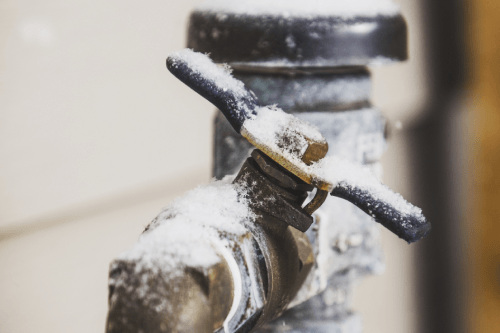Safeguarding Your Pipes from Freezing Issues: Critical Strategies
Safeguarding Your Pipes from Freezing Issues: Critical Strategies
Blog Article
Presented here on the next paragraphs you can find some incredibly good guidance regarding Prevent Frozen Pipes .
.jpg)
Cold weather can ruin your plumbing, particularly by freezing pipes. Below's how to prevent it from occurring and what to do if it does.
Introduction
As temperature levels decrease, the threat of icy pipelines increases, potentially bring about costly repairs and water damage. Recognizing how to stop frozen pipes is essential for house owners in cold climates.
Recognizing Frozen Pipelines
What causes pipes to ice up?
Pipes freeze when subjected to temperature levels below 32 ° F (0 ° C) for expanded periods. As water inside the pipelines freezes, it broadens, taxing the pipe wall surfaces and possibly creating them to burst.
Dangers and problems
Frozen pipes can cause water supply interruptions, home damages, and costly repair services. Ruptured pipelines can flooding homes and cause comprehensive structural damage.
Indications of Frozen Water Lines
Recognizing icy pipelines early can stop them from breaking.
How to recognize icy pipelines
Look for reduced water flow from taps, uncommon odors or noises from pipes, and noticeable frost on revealed pipelines.
Prevention Tips
Protecting susceptible pipes
Wrap pipes in insulation sleeves or utilize heat tape to protect them from freezing temperature levels. Concentrate on pipes in unheated or exterior areas of the home.
Home heating techniques
Keep interior spaces appropriately warmed, specifically locations with pipes. Open cupboard doors to permit cozy air to flow around pipelines under sinks.
Securing Outside Pipes
Garden tubes and exterior faucets
Detach and drain pipes yard hoses before winter season. Install frost-proof faucets or cover outdoor taps with shielded caps.
What to Do If Your Pipelines Freeze
Immediate actions to take
If you think frozen pipes, maintain taps open up to ease stress as the ice thaws. Make use of a hairdryer or towels taken in warm water to thaw pipelines gradually.
Long-Term Solutions
Architectural changes
Take into consideration rerouting pipelines far from outside wall surfaces or unheated locations. Add additional insulation to attics, cellars, and crawl spaces.
Updating insulation
Purchase high-grade insulation for pipes, attics, and wall surfaces. Correct insulation assists preserve regular temperature levels and decreases the threat of frozen pipelines.
Verdict
Preventing icy pipelines calls for positive actions and quick actions. By comprehending the causes, indications, and preventive measures, home owners can safeguard their pipes throughout winter.
6 Proven Ways to Prevent Frozen Pipes and Protect Your Home
Disconnect and Drain Garden Hoses
Before winter arrives, start by disconnecting your garden hoses and draining any remaining water. Close the shut-off valves that supply outdoor hose bibs and leave the outdoor faucet open to allow any residual water to drain. For extra protection, consider using faucet covers throughout the colder months. It’s also important to drain water from any sprinkler supply lines following the manufacturer’s directions.
Insulate Exposed Pipes
Insulating your pipes is an effective way to prevent freezing. Pipe insulation is readily available at home improvement stores and is relatively inexpensive. Pay close attention to pipes in unheated areas such as the attic, basement, crawl spaces, or garage. Apply foam insulation generously to create a buffer against the cold. You can also wrap your pipes in heat tape or thermostat-controlled heat cables for added warmth.
Seal Air Leaks
Inspect your home for any cracks or openings that could let in cold air. Seal any holes around the piping in interior or exterior walls, as well as the sill plates where your home rests on its foundation. Additionally, make sure to keep your garage door closed unless you’re entering or exiting. Leaving it open creates a significant air leak that can lead to frozen pipes.
Allow Warm Air Circulation
During cold snaps, it’s essential to allow warm air to circulate evenly throughout your home. Leave interior doors ajar to promote better airflow. Open kitchen and bathroom cabinets to help distribute heat consistently around the rooms. If you have small children or pets, be sure to remove any household chemicals or potentially harmful cleaners from open cabinets for safety.
Let Faucets Drip
A small trickle of water can make a big difference in preventing ice formation inside your pipes. When temperatures drop significantly, start a drip of water from all faucets served by exposed pipes. This continuous flow helps prevent the water from freezing. Additionally, running a few faucets slightly can relieve pressure inside the pipes, reducing the chances of a rupture if the water inside does freeze.
https://choateshvac.com/6-proven-ways-to-prevent-frozen-pipes-and-protect-your-home/

Hopefully you enjoyed our article about 6 Ways to Prevent Frozen Pipes. Thanks so much for finding the time to read our blog post. In case you enjoyed reading our blog entry if you please consider to pass it around. Thank you for being here. Return soon.
Detail Report this page